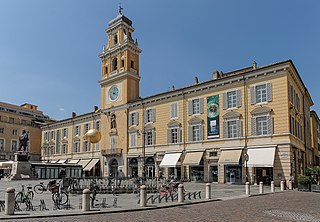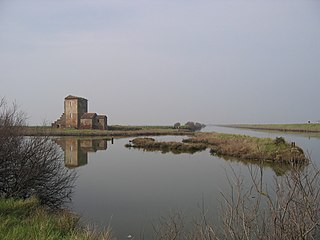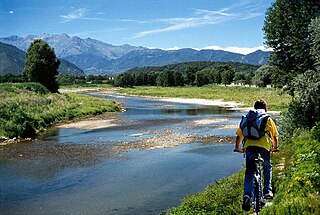
Parma is a city in the northern Italian region of Emilia-Romagna known for its architecture, music, art, prosciutto (ham), cheese and surrounding countryside. With a population of 198,292 inhabitants, Parma is the second most populous city in Emilia-Romagna after Bologna, the region's capital. The city is home to the University of Parma, one of the oldest universities in the world. Parma is divided into two parts by the stream of the same name. The district on the far side of the river is Oltretorrente. Parma's Etruscan name was adapted by Romans to describe the round shield called Parma.

The Taro is a river in Emilia-Romagna, in northern Italy. It is a tributary of the Po and is 126 kilometres (78 mi) long. It flows almost entirely in the province of Parma, west of the city Parma. The Taro flows into the Po near Gramignazzo, a frazione of the comune of Sissa, north of Parma.

Val Camonica is one of the largest valleys of the central Alps, in eastern Lombardy, Italy. It extends about 90 kilometres (56 mi) from the Tonale Pass to Corna Trentapassi, in the commune of Pisogne near Lake Iseo. It has an area of about 1,335 km2 (515 sq mi) and 118,323 inhabitants. The River Oglio runs through its full length, rising at Ponte di Legno and flowing into Lake Iseo between Pisogne and Costa Volpino.

Bardi is a comune (municipality) in the Province of Parma in the Italian region Emilia-Romagna, located about 130 kilometres (81 mi) west of Bologna and about 50 kilometres (31 mi) southwest of Parma, in the upper Ceno valley at the confluence of the rivers Ceno and Noveglia. It is dominated by the imposing Landi Castle built over a spur of red jasper.

The Stirone is a small river of Emilia-Romagna in north Italy, a left tributary of the Taro, which it joins shortly before the latter enters the Po.

The Geography of Piedmont is that of a territory predominantly mountainous, 43.3%, but with extensive areas of hills which represent 30.3% of the territory, and of plains (26.4%).
Emilia is a historical region of northern Italy, which approximately corresponds to the western and the north-eastern portions of the modern region of Emilia-Romagna, with the area of Romagna forming the remainder of the modern region.
The Val d'Aveto, or Aveto valley, straddles the Province of Genoa and the Province of Piacenza, between the Italian regions of Liguria and Emilia-Romagna. The river Aveto runs through the valley, to later join its waters with those of the Trebbia near the hamlet of Confiente. The upper, Ligurian part of the valley comprises the Comuni of Rezzoaglio and Santo Stefano d'Aveto; the lower, Emilian part of the valley is divided between Ferriere, Cerignale and Corte Brugnatella. Verdant and lush, characterized by pleasant sights, fresh and balmy summers and abundant snow in winter, the valley is flanked by forested mountains, culminating at the elevation of 1799 meters with Monte Maggiorasca.

The Valli di Comacchio, meaning "fish basins of Comacchio", are a series of contiguous brackish lagoons situated to the south of Comacchio, close to the Adriatic coast of the Emilia-Romagna region in northern Italy. They lie within the comuni of Comacchio and Argenta in the province of Ferrara and the comune of Ravenna in the province of Ravenna.

The Sangone is a torrent river in the Metropolitan City of Turin, Piedmont, north-western Italy.

The Sanvitale conspiracy was a plot to assassinate Ranuccio I Farnese, Duke of Parma and Piacenza, and members of his family at the baptism of his new-born son Alessandro in 1611. The conspiracy may also be referred to in Italian as the congiura dei feudatari, "conspiracy of the feudal lords", or as the congiura del 1611, "conspiracy of 1611".

The Val Nure is the valley of the Nure river, a tributary of the Po. The valley lies almost entirely in the Province of Piacenza, in the Emilia-Romagna region of Italy. It forms part of the Comunità Montana Valli del Nure e dell'Arda.

Val Grande National Park is a protected area located in Piedmont, in the north of Italy, at the border with Switzerland. It is most notable for landscapes of the High Alps.

The Po is the longest river in Italy. It flows eastward across northern Italy starting from the Cottian Alps. The river's length is either 652 km (405 mi) or 682 km (424 mi), if the Maira, a right bank tributary, is included. The headwaters of the Po are a spring seeping from a stony hillside at Pian del Re, a flat place at the head of the Val Po under the northwest face of Monviso. The Po then extends along the 45th parallel north before ending at a delta projecting into the Adriatic Sea near Venice.

The Landi were a noble family from Piacenza, in northern Italy. From 1551 to 1582, they were princes of the Val di Taro, now in the province of Parma, at that time in papal territory. Their principality is sometimes called Lo Stato Landi ; although the term is not well known, there is substantial documentation of it in the Archivio Segreto Vaticano, in the Vatican City.

The Tidone is a river in the Region of Emilia Romagna in northern Italy. It is a right-bank tributary of the Po River. The stream rises in the Apennine Mountains near Monte Penice and flows in a northerly direction into the Po.
The following is a timeline of the history of the city of Parma in the Emilia-Romagna region of Italy.
Corte di Giarola is an Italian medieval rural court with an inner church, located in the village of Pontescodogna, part of commune of Collecchio, in Province of Parma. Corte di Giarola is presently a multi-purpose facility. It includes the headquarters of the Ente di Gestione per i Parchi and Biodiversità Emilia Occidentale. It also hosts the Museum of Tomato, the. being part of Museum of Food, the Museo Sotto il segno dell'Acqua which is an exhibition trail dedicated to the Taro River Regional Park, in addition to small 99-seat theatre called Teatro alla Corte, plus an auditorium hall, two conference rooms and a restaurant.
Sanvitale is an Italian surname. It may refer to:


















